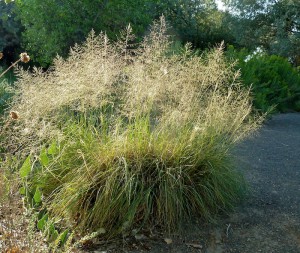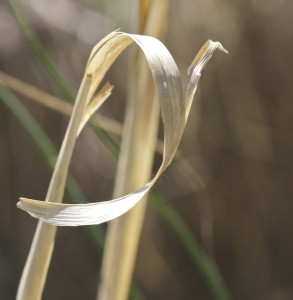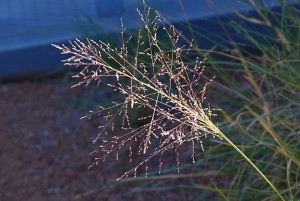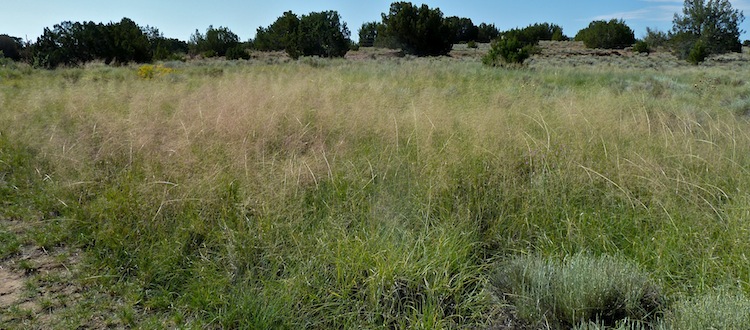Scientific Name: Sporobolus airoides
Plant Family: Poaceae (Grass)
Common Name: Alkali sacaton
By Janice Tucker

Alkali sacaton
The annual visual feast of Santa Fe in living color will soon descend upon our landscape, enticing us to revel in the parade of golden aspens and cottonwoods, red sumacs, yellow chamisas as well as the abundance of yellow, white and purple asters. Behind the riotous hues there is a subtler element of the autumn palette. The warm season grasses that fill in the background with soft colors, textures and graceful movement quietly add to the mood of the season. The Alkali sacaton (Sporobolus airoides) is among the most beautiful of these grasses. Its solid base of silvery-green leaves and wispy, slightly reddish seed heads borne on tall, erect stems are particularly striking when backlit by early morning or late afternoon sun.
Native to all the western United States, the Alkali sacaton normally grows in elevations between 4200 to 6200 feet. It is a long-lived, perennial, bunch grass with dense, basal foliage often spreading up to 3 feet wide and growing to approximately 3 feet tall. The gray-green leaves are tapered and are often as long as 1-½ feet. One identifying characteristic is the way the leaves curl as the plant goes into dormancy. The deep, penetrating roots are glossy and fibrous, making it a popular choice for erosion control.

Alkali sacaton curled leaf
The seed heads are literally the crowning glory of Alkali sacaton. In the summer tiny, yellow inconspicuous flowers appear, eventually developing into triangular-shaped, delicate, feather-like seed heads that rise on sturdy stems from 4 to 16 inches above the dense base of the plant. The seed head spikelets contain one floret.
The grass primarily spreads by seed dispersal, which is best described in the definition of the genus. Sporobolus is a combined Greek word, sporos (seed) and bolos (throwing). The name depicts the way the fertile, ripe seeds are released from the seed head in late summer through mid-fall, germinating in about 9 months. The seeds can remain viable for years. Alkali sacaton also spreads from tillers, which are shoots that extend from the roots.

Alkali sacaton seed head
Cold tolerant to Zone 4, Alkali sacaton usually grows in alkaline, moist soils but also adapts well to sandy, loam, clay and even caliche. Whatever the soil, Alkali sacaton should be kept moist but not saturated. It is often used as an ornamental landscape grass. In addition to the Alkali sacaton, many landscape architects choose the taller Giant sacaton (Sporobolus wrightii) in their garden designs.
The species name, airoides is traced from the aira species to lolium, which is Latin for a type of rye grass. The “oid” indicates that it is similar in appearance to the aira or lolium species. The common name Alkali sacaton denotes the preferred alkaline soil and sacaton has its origins in the Aztec/Nahuati word zacatl (grass).
Alkali sacaton has been touted as an indicator of potable water within a few feet from the surface. Its seeds provide food for birds and the thick foliage offers protected shelter for nesting. When the foliage is young and succulent, it provides good forage for cattle and horses but is not considered desirable for sheep. The plants in the genus Sporobolus are called popote de cambray when used in straw mosaics also known as popotillo art, a Mexican craft that has Pre-Columbian roots.
The mature, lacy seed heads of the Alkali sacaton take on a reddish to purplish hue. When seen en masse, this grass can turn a field into a sea of softly colored, undulating movement. While visiting Santa Fe Botanical Garden’s Leonora Curtin Wetland Preserve this fall, take in the bright, bold colors and the fields of Alkali sacaton gently waving at all who take a moment to enjoy their beauty.

Alkali sacaton field


